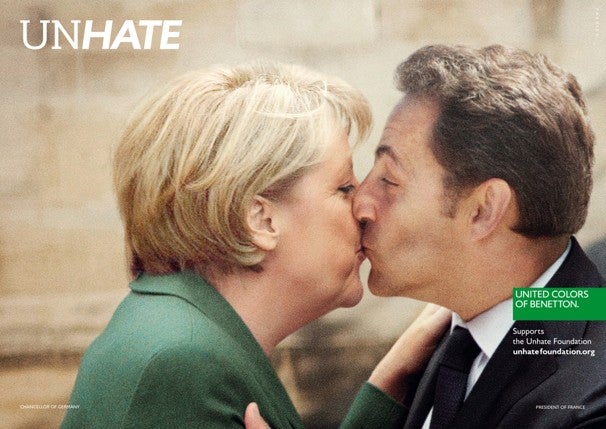Benetton’s “Unhate” Ad Campaign Photoshops World Leaders Kissing
The clothing company that is no stranger to courting controversy with altered images faces legal action from the Vatican for their latest ad.


Benetton Kiss
Benetton, purveyor of rather inoffensive, if not overpriced clothes, sure has a handle on how to get people to pay attention to their ads, and it has nothing to do with the stuff they sell.
The Italian clothing company has a long history of what’s sometimes deemed “shockvertising.” In 1990 Benetton produced posters of a priest kissing a nun; a bloody newborn baby, and a black stallion mounting a white mare. Other controversial ads featured a black woman breast feeding a white baby and a Photoshopped image of a real AIDS patient on his deathbed surrounded by a grieving family. The message behind the ad campaigns is always one of acceptance and tolerance, but it’s sometimes lost in the public outcry of offence.
The latest campaign, titled “Unhate” launched on Wednesday and instantly made headlines across the globe. It features digitally manipulated images of several political nemeses in lip-locked embraces, including Barack Obama and Venezuela’s Hugo Chavez, Israeli Prime Minister Benjamin Netanyahu and Palestinian President Mahmoud Abbas, French President Nicolas Sarkozy and German Chancellor Angela Merkel, and the paring that’s gotten the most attention: Pope Benedict XVI kissing a top Egyptian imam.
The White House waited until late Thursday morning to issue a statement saying succinctly, “”The White House has a longstanding policy disapproving of the use of the president’s name and likeness for commercial purposes.” The Vatican, however sprang to action much more quickly saying it planned to take legal action to stop the distribution of the doctored images, that they claim are “damaging to not only to dignity of the pope and the Catholic Church but also to the feelings of believers.”
Benetton followed by removing ads in Italy featuring Pope Benedict XVI, and issued a statement saying that the ad’s intent was “exclusively to fight the culture of hate in every form” and “We are sorry that the use of an image of the pontiff and the imam should have offended the sensibilities of the faithful in this way.”
The image is of course still widely available on the web, and despite the Vatican’s protests it will be difficult if not impossible to erase the image’s existence everywhere.
Benetton’s in-house communications agency Fabrica was behind the work.
What do you think? Do these types of images convey the Benetton’s message? Are they offensive? Should the company asked permission to use the leader’s images?
Whatever your stance, if the goal of an advertising campaign is get people to notice and talk about the company, they Benetton was certainly successful.
Via. Washington Post